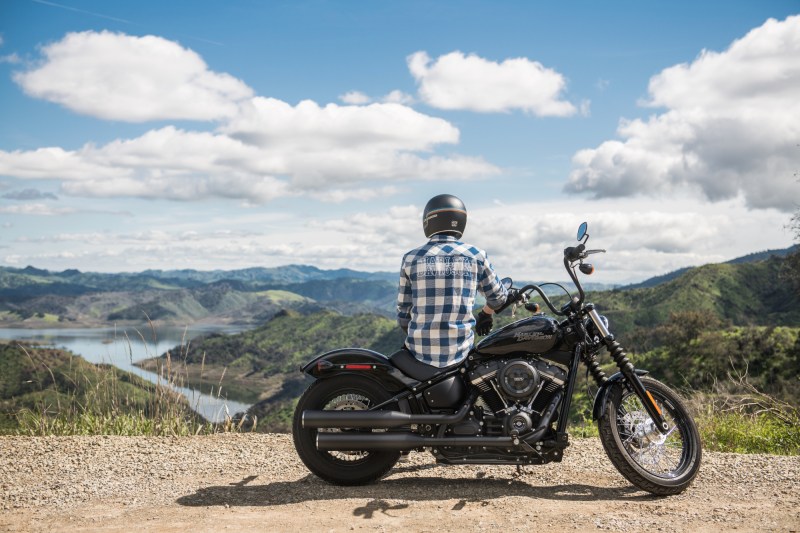You know how there are hair product commercials in which a guy takes off a hat or helmet, shakes his head, and showcases his perfect, thick mane? It epitomizes the trend of Instagram vs. reality. If you’ve had helmet hair (or hat hair) after riding a bike, motorcycling, snowboarding, or rooting for the home team at a baseball game, you know what we’re talking about. Helmet hair is a beast, and it can make even the most confident dude a little self-conscious.
“Nobody wants to show up looking like they just got out of bed on the wrong side,” said Vito Esposito, a celebrity hairstylist
and the owner of Vito Esposito Salon. “Hair gives you your look, your presence. When it’s smashed under the helmet, bent in weird ways, it can make you feel not yourself.”
To help you arrive confident, Esposito and another hair pro shared tips for managing and preventing helmet hair.
How to get rid of helmet hair

Wearing a helmet is essential for both bike riding and motorcycling. It’s possible to quickly manage helmet hair with minimal products and a good shake. Also? Understandably, you want to control and ward off this hairy situation.
Esposito knows the struggle with helmet hair is real. You don’t want to roll up “like you fought with your scooter and lost,” he said. He and another pro shared their favorite tips for busting helmet and hat hair.
Apply a leave-in conditioner or light styling cream before putting on your helmet
The process of treating hat and helmet hair starts before you put anything on your head.
“[Leave-in conditioner or light styling cream] helps because it gives your hair a bit of structure and moisture without making it stiff and crunchy,” said Dean Banowetz, a celebrity hairstylist and the founder of Hollywood Hair Guy Academy. “It helps to minimize the chance of your hair getting frizzy or flattened. Take a small amount of leave-in conditioner, rub it between your palms, and work it evenly through damp or dry hair. Focus on mid-length to ends, not the scalp.”
However, don’t overdo styling or product.
“That’s a waste of good product,” Esposito said. “[The] helmet goes on, [and the] hair gets smashed. Instead, wait until after the ride, when you can see what your hair is doing and fix it properly.”
Shake and flip
Those guys who take their helmets off and shake their heads? They may not just be showing off their long, luscious locks. Banowetz suggests shaking or flipping your head over to loosen the hair the moment you take off the helmet or cap.
“This might sound crazy, but it works,” Banowetz said. “When you flip your hair and give it a good shake, you’re helping it bounce back from being compressed. Run your fingers through your hair to help break up the style as well.”
Use volumizing tonic and wax or pomade
After you’ve done the shake and flip, spritz some volumizing tonic into your locks.
“This wakes it up again, gives volume, light hold, and a clean finish with no sticky feeling,” Esposito said. “You feel like yourself again.”
From there, Esposito recommended wax or pomade to improve movement and leave hair feeling touchable.
“You want that casual, easy look, not stiff or crunchy,” Esposito said. “This is refined styling, but rilassato — relaxed. Just work it into dry hair with your hands and shape as you like — messy, neat, off the face, whatever you like.”
Cover-up
Don’t have time to style once you arrive? Cover up the helmet hair and call it a good hair day.
“My go-to is throwing on a stylish cap or beanie,” Banowetz said. “It is the easiest, fastest fix.”
How do I avoid helmet hair?

Helmet hair isn’t inevitable, even if you do have to wear head protection. Ensuring your helmet fits properly and remains clean can ward off helmet hair. It can also help you avoid hair loss, though stylists say that headgear doesn’t directly cause shedding.
“The way a helmet is worn can contribute to it over time,” Banowetz said. “If a helmet is too tight, it can pull on your hair and scalp, causing a condition called traction alopecia, which is hair loss from repeated pressure or friction.”
To prevent helmet hair and lock loss, Banowetz suggested:
- Make sure the helmet fits correctly. Banowetz noted that helmets should be snug but not too tight. Ensure the helmet stays put “without leaving deep marks on your forehead or pulling your hairline.”
- Clean the inside of your helmet regularly. “Sweat, oils, and dirt build up over time, and that can lead to clogged pores or scalp irritation,” Banowetz said.
- Wear a moisture-wicking skull cap or bandana underneath. Banowetz said this layer between your hair and helmet reduces friction and sweat absorption. Again, the headwear should fit comfortably and be breathable.
- Go short. Banowetz said shorter ‘dos are less likely to have horrible helmet hair. Fades and buzz cuts are two of his favorites.
- Stay long. Not ready to part with long locks? “Tie it loosely at the base of the neck before riding — not tight,” Esposito said. “You want to avoid creases.”
Helmet hair happens

To some extent, helmet hair is a product of you taking the critical step to keep your head safe. Still, you can minimize it with some practical steps, like ensuring a good fit and cleaning the helmet regularly. A breathable bandana can also help. These tips can also help ward off hair loss indirectly triggered by helmets and other headwear, such as caps. If helmet hair has already happened, shake and flip the hair, and consider using a volumizing spray and wax or pomade to add fast style and texture to your mane. In a pinch, a good ‘ole beanie will hide helmet hair.




